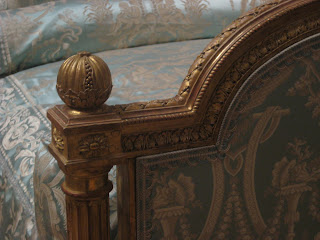


In the Ann and William Elfers Gallery at the Boston Museum of art is a exquisite set of 18th century French furniture of the Louis XVI period. The suite of bedroom furniture consist of a bed, Kneeling Chair, Bergere, Firescreen, 2 Armchairs, and 4 Side Chairs made by Jean-Baptiste-Claude Sené, French, 1747–1803. This suite of furniture was delivered to Marc-Antoine Thierry de Ville d'Avray in 1787, intendant-general of the Garde-Meuble de la Couronne, Paris. Marc-Antoine Thierry enjoyed his beautiful furniture for five years. After the downfall of the monarchy on August 10, 1792, Thierry was imprisoned and his belongings were seized by the French Revolutionary government in 1792. He died in the massacres at the Prison de l'Abbaye in September, 1792.
Portrait of James Swan by Gilbert Stuart, 1795
Sometime between 1794-1796 this set of furniture was acquired in Paris by James Swan (1754 – July 31, 1830) an early American patriot and financier. James Swan was a merchant established in Paris, and was appointed an official agent for the purchase of supplies in the United States in 1794 by the French Government. His partner was Johann-Caspar Schweizer, a Swiss. The French Government placed at his disposal luxury goods to be exchanged in America for food supplies and war materials. The Swan and Schweizer agency shipped these articles to the United States between 1794-1795, where much of it was sold. However, this suite of bedroom furniture was among those that Swan kept for his personal use.
The Swan House located on Dudley Street
James Swan used his French furniture at The Swan House located on Dudley Street at the corner of Howard across from the Morton-Taylor House. The Neoclassical Federal style house was built about 1796 as a summer home for James and his wife Hepzibah Swan following a design ascribed to Boston architect Charles Bulfinch. A balustrade, as shown on the wings, originally encircled the top as well. The center of the house was round and contained only one room, the colonial dining hall. The dining hall was thirty-two feet in diameter, two stories high, with a huge dome-shaped ceiling. This room was the drawing room but since it was the only room, it probably served as the dining hall for large parties]. General Lafayette, General Henry Knox and many other Revolutionary war heroes were entertained at the Swans residence.
French furniture like this beautiful and refined set displays the highest level of artistic and technical ability. French furniture of this period was the collaborative effort of various artists and craftsmen who worked according to strictly enforced guild regulations. Established during the Middle Ages, the guild system continued with little change until being dissolved in 1791 during the French Revolution. The Parisian guild to which the furniture makers belonged was called the Corporation des Menuisiers.
This set was made byJean-Baptiste-Claude, Sene became a master menuisier at the age of twenty-one, continuing the family precedent set by his father and grandfather. He created furniture for the French royal family, notably a bed made for Marie Antoinette. After the French Revolution, Sene worked as an administrator for the new republican government, a position that allowed him to continue making furniture unlike most of his competitors.


From beginning to end this set of seated furniture passes thru many hands due to the Paris guild. A joiner would ruff out the wood pieces and join them together. Then the unfinished pieces were sent to a master carver were the pieces were carved with neoclassical acanthus leaf motif, flutes and medallions. After being carved this set was sent to Parisian painter-gilder Louis Chatard. The set was originally painted but was gilded on top of the paint. We know this because Louis entered a charge for painting the ten pieces of furniture in his account book, then, in a later entry dated August 1787, crossed out the painting and wrote in gilding. Thierry de Ville d'Avray visited the workshop while work was in process and had it change.
After gilding the set was sent to master upholsterer Claude-Francois Capin. Thierry use leftover three-color silk lampas that was originally woven for the King's Gaming Room at Fontainebleau, The elegant pattern is a characteristic neoclassical arabesque design attributable to Jean-Demosthene Dugourc. The silk lampas depicts four major motifs representing the Four Elements: spaniels (Earth), winged sea horses (water vapor, or Water), river gods (Water), and a cyclops forging Jupiter's thunderbolts (Fire). The fabric was originally woven by the Lyons firm, Reboul, Fontebrune et Compagnie . We are truly lucky to have fine examples of french furniture like this in America.
































With the passage of time the design in furniture has also changed. But it is always advisable to choose the latest or modern one other than going for an outdated one. sk home furniture
ReplyDelete